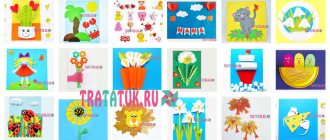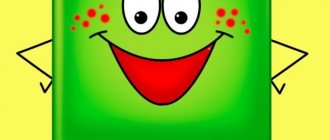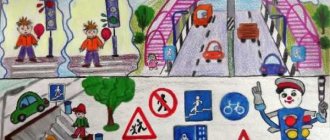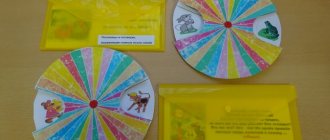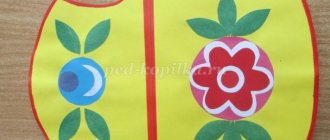Drawing from geometric shapes is a task for preschool and primary school children that allows them to develop spatial imagination, knowledge of geometric shapes and improve motor drawing skills.
For your convenience, we have made coloring pages of geometric shapes that you can print and color (for preschoolers). After each coloring, an example of a drawing on the same topic is presented. Children complete the drawing independently using a ruler and color it with paints or pencils (for schoolchildren). Coloring pages and drawings are made on the following topics:
- "Air Transport"
- "Toys"
- Animals from geometric shapes “Cat and Mouse”
- "Transport"
- "House in the village"
- "Sea and Ship"
- "Railway"
- "Forest New Year's Tale"
- "Summer Glade"
- "Space flight"
Drawings of geometric shapes for children - lesson plan
- Start the lesson by finding out what geometric shapes the child remembers. He must confidently name and see circle (semicircle), oval, square, triangle and polygon . Older children will be able to see the broken line in the drawings.
- Find the geometric shapes in the picture. The more geometric shapes a child finds, the better. You can count them.
- Fill the coloring book with color or draw the selected composition. It is very good if the child goes further and draws his own elements of the picture.
Article:
Introduce your child to geometric shapes: circle, square (rectangle), triangle.
Show him these figures in drawings and cut out of paper. Teach to find their forms in the environment. Use the didactic game “Miracle Bag”: a fabric bag contains small objects of different geometric shapes, made of wood or plastic. Together with your child, cut out a set of these shapes of different sizes and colors from colored paper. Train your child to select only triangles, or only circles, or squares from a variety of cut-out shapes. Teach your child to draw these figures, first on a sheet of paper, then using a stencil, and later using a ruler and compass. Miracle bag
You can use the “Miracle Bag” set for the game or just a bag made of opaque fabric, and several small objects of different shapes specially selected for the game: square - boxes, chewing gum, cube, ball, ball, ball. Ask your child to take out all the round objects first, then all the square ones. Check that the task is completed correctly.
Ride through the gate
Introduce your child to the geometric shapes cube and ball. Play the following board game: invite your child to roll a cube and a ball through the gate (we denote it on the table with two cubes). Let the child try to complete this task. Then analyze his observations with him: “The ball is round in shape, so it can easily roll or stand still, but a cube cannot roll, the corners interfere with it. It can stand still or be turned from side to side. His sides are all the same.”
Patterns of geometric shapes
From colored paper, cut out several equilateral triangles (12 or more). Who will put together the most figures? What geometric shapes can be made from them? Square, rectangle, triangle. You can assemble a star from 12 triangles: first, assemble the center of the star - a hexagon. Then from the remaining six triangles you make rays towards it.
Triangle
Show your child a geometric figure - a triangle. Explain why it is called that - because it has three corners. Let the child name the triangular objects in the environment. Play with the “miracle bag”, let the child take out all the triangular-shaped objects from it.
Houses
Give your child a set of paper triangles - two squares, one larger, one smaller cut diagonally, and a figurine of a paper animal (hedgehog, bunny). Invite your child to assemble a house for a paper animal from triangles. All available triangles must be used in the construction of the house. There may be several options. If your child finds it difficult to find several options, help him.
Christmas trees
Give your child a set of three triangles with equal sides. Invite your child to make Christmas tree shapes from these triangles. There can be two versions of the herringbone: the first - three triangles are located one above the other, touching the top of the lower one with their base, the second - the lower large triangle is made up of two small ones, with adjacent sides, and the upper triangle touches the base of the top of the lower one. Most likely, the child will collect the first option. Offer him the second option. Let him compare two Christmas trees and say which one is taller and which one is lower.
Fish
Give your child a set of four identical paper triangles; make the triangles from two identical squares cut in half. Invite him to collect different fish from them using any means (you can’t put triangles on top of each other). You will get 4 variants of fish. The most interesting fish can be turned into an applique.
Square
Show your child the square, tell him what this figure is called and what is its peculiarity: all sides of the square are the same. How can I check this? Let the child offer his own options. Then show him how else you can do this: alternately fold the square along two diagonals. If the sides coincide when superimposed one on one, then they are the same, and this figure is a square. Invite your child to make a square using sticks. Do not specify the number of sticks. Perhaps he uses one stick per side, or perhaps several. Depending on this, invite him to fold a larger or smaller square. Let the child name square-shaped objects in the environment.
A child or group of children is offered a set of five squares and five triangles of different sizes and colors, as well as paper figures of five gnomes in multi-colored caps. An adult tells the children that a strong wind tore the roofs off the gnomes' houses and asks them to fix them - to assemble houses from rectangles and triangles, choosing a triangle - a roof for each square house. Let the children explain by what signs they will determine which roof belongs to which house (by size, by color). When the houses are assembled, you need to take each gnome to his house, focusing on the color of the cap.
Rectangle
Show your child a paper rectangle. Name it. Compare the overlay method with a square half the size. Analyze how a rectangle differs from a square? A square has all equal sides, and a rectangle has equal top and bottom, left and right sides (opposite). Show your child paper rectangles of different shapes, check the equality of their opposite sides by folding the rectangles in half. Have your child name rectangular objects.
Select what you need
On a tray in front of the child are geometric shapes of different sizes and colors. You give the child various tasks: name all the figures that lie in front of him, lay out all the triangles from the tray onto the table; all squares; all rectangles; all the figures are of a certain color, the figures are of a certain shape and a certain color, the figure is large or small. Count them.
Collect the figure
Offer your child a large set of different geometric shapes: squares, isosceles triangles, rectangles of different sizes. Invite him to assemble geometric shapes of different sizes from any shapes he knows. He can use any shapes and any methods of their arrangement. The more options, the better.
How many points?
A large sheet of whatman paper is drawn with lines into different geometric shapes: rectangles, squares, triangles. A child and an adult alternately throw a dice onto a piece of paper and see which figure it lands on. Agree in advance how many points are given for a piece of a certain shape, for example: triangle - 1 point, square - 2 points, rectangle - 3 points, as well as how many throws can be made. That one will win. Who will get more points in a certain number of moves. One child can play. Then the task will be different: from a set of paper figures, find a figure of the same shape on which the cube fell.
Geometric relay
Game for a group of children. Children are divided into two teams and stand behind each other at one end of the room. There is a chair next to each team. On the opposite side of the room, there are square and round objects mixed together on the table. At the signal, the players of each team run to the table, take the object: the players of one team are round, and the other is square, carry it to the rest of the team members and place it on a chair. Then other team players run for the items. This continues until each participant brings an item. The team that finishes first and without mistakes wins.
Labyrinths
You can draw the mazes yourself with your child or use samples. Check the statement that you can get out of any maze if you turn only to the left.
Tangram
Tangram is an oriental puzzle, which is a square with a side of 8 cm, cut into seven parts, from which you can create a large number of different figures and patterns.
Games with counting sticks
Games with counting sticks also develop ideas about geometric shapes.
Game 1 . Make a square and a triangle from counting sticks, the sides of which consist of 1 stick.
Game 2 . Make a rectangle out of counting sticks, with sides 2 sticks and 3 sticks.
Game 3 . Make two squares from 10 sticks - large and small; You will place the small one inside the large one, using the sides of the large square when constructing.
Game 4 . Make a square and two identical triangles from five sticks.
Teach your child to use measuring strips of paper to measure objects. Play the following games with him:
Game 1. Four children are playing. They are sitting at the table. Game 4 each has a picture with two Christmas trees, one tree is higher, the other is lower, and two strips of paper the same length as the trees. Children are asked what needs to be done to find out which tree is taller. Assignment: measure the Christmas trees and draw a mushroom next to the one above. Possible options: measure the Christmas trees with different strips, which then compare with each other; measure with one strip. Once each child has measured their Christmas tree and determined which is taller, ask the children to determine which person at the table has the tallest tree? How to determine this? If the children find it difficult to answer, prompt them: they need to take the measurement of their tall Christmas tree and compare it with the measurements of the tallest Christmas trees of other children.
Game 2 . Four children are playing. In front of each is a picture of a ladder, scissors and a measuring strip. An adult puts a picture of a street lamp on the table and says: “This is a street lamp. It's broken, it needs to be fixed. For this you need a ladder. What kind of ladder can you use to repair a lantern?” Children should come to the conclusion that they need to use a measuring strip: use it to measure the height of the pillar, and then the length of each ladder and choose the one they need.
Cut out a set of strips of different lengths and widths from colored paper and regularly practice comparing them using the overlay method. When comparing, use the words: longer, wider, narrower, shorter. Compare objects in your environment using adjectives: narrow, wide, long, short, high, low, as well as comparisons: higher, lower, wider, narrower.
Game 1. Invite the child to list objects of a certain size: a) tall; b) low; c) wide; d) narrow.
Game 2. Let the child list objects of a certain shape: a) triangular; b) rectangular; c) round.
Game 3 . Invite your child to list things made of a certain material: a) glass; b) wooden; c) metal, etc.
Game 4. Toss the ball with the child, saying words of opposite meaning, denoting quantities: high-low, short-long, wide-narrow, thick-thin, etc.
Game 5 . Hide two pairs of toys (dolls, bears) in the apartment - toys in one pair are the same height, and in the other - different. Let the child find them and explain how they differ in height in pairs and among themselves.
Game 6. While walking, draw wide and narrow paths on the ground with a stick. Invite your child to jump over them. Which tracks were easier to jump over? Why? It's easier through narrow ones, since they are narrower.
Game 7 . During a walk, invite your child to measure his height with the children in the yard, standing back to back. Discuss who is taller, who is shorter, who is taller than everyone else. Reassure the one who turned out to be the lowest by telling him that he will still grow.
Game 8 . Place pots of different sizes in the kitchen and ask your child to choose the right lids for them. Which ones didn't fit, why? (Different sizes, larger, smaller). Which ones suited you, why? (The same). Compare the lids and saucepans with each other.
Game 9. You throw the ball with the child, naming the object and the sign of the object for each throw. The child, having caught the ball, must answer you with a phrase that has the opposite meaning. Objects can be very different, the main thing is that their characteristics are directly opposite to each other. For example: the tap is high - the hut is low, the knee socks are long - the socks are short, the path is narrow - the road is wide.
Game 10. Invite your child to measure the thickness of tree trunks while walking in the park. Thick trunks cannot be grasped with your hands, but thin ones can.
Game 11. Select objects of different sizes: two ribbons of different lengths, two bottles (with a narrow and a wide neck), two cans - high and low, two books - thick and thin, two balls - small and large. The child must look at all the objects, and when he turns away, you remove one of them. The child, turning around, must guess which object has disappeared and characterize its signs. Repeat the game several times.
Game 12 . A group of children is playing. Children stand in a circle, and an adult with a ball stands in the center of the circle and says: “Pencil, which is longer?” The child must name in response the object that is longer and throw the ball back. The ball can be thrown until the comparisons run out. You can ask what is shorter, for example: “The road is long, what is shorter?”
Game 13 . This game can be played outside. A line is drawn on the ground where you need to throw pebbles (in winter these can be snowballs). You can't go beyond the line. You can only throw pebbles when given a signal. The one who throws the farthest wins. Ask the question, how to compare, who threw further? How to measure? You can measure by steps, feet, etc.
Game 14. A pair of children sitting at a table is playing. Each person gets the same pyramid. Then the children remove the pyramid rings from the rod and mix them. Ask the children to sort the rings in order from smallest to largest. Then mix the rings again and choose identical pairs. Paired rings are found by overlapping each other.
Game 15. To play you will need several sets of sticks. Each set should contain 15-20 sticks of four to five sizes, for example 3, 4, 5, 6, 7 cm long.
It is advisable that the sets be of different colors. Both sets are mixed and laid out on the table in front of the child. His task is to sort the sticks by size and put them in separate piles. The game becomes more complicated if the sticks differ from each other in two ways: for example, in length and thickness.
Composition of geometric shapes drawing “Air transport”
Drawing of geometric shapes 1st grade - air transport. An airplane, a hot air balloon and a helicopter will pique the interest of boys. You can tell interesting facts about the structure of transport, its speed, the history of its creation and its role today.
Coloring page "Air transport made of geometric shapes"
Drawing “Air transport from geometric shapes”
Learning geometric shapes with kids: main rules
Important: How to teach your child to name and distinguish geometric shapes easily and quickly! To do this you need to adhere to certain rules. With chaotic, inconsistent learning, the baby may confuse the figures and not see their similarities and differences.
- Teachers insist that when teaching at home, systematicity, consistency, and accessibility should be the main rules. There is no need to torture yourself and your child with any abstruse tasks and manuals; it is enough to use educational books, toys (construction sets, blocks, cars, doll dishes) and familiar surroundings (furniture, household items, dishes).
- Acquaintance with new figures must be carried out through research activities: invite the baby to feel, trace the outline with a finger, “draw” in the air, put the figures together, roll, stick into holes.
- A child will quickly master new material if he practically interacts with it in games, creative activities, looking at and reading books, and everyday activities. For example, when introducing a square to a baby, you can ask him to find square objects in the environment: a seat next to a highchair, a handkerchief, the face of a cube, a napkin. While walking, ask what shape is the bench in the park, the wall of the house, mom’s bag, the ball that the older kids play with. At the same time, the adult himself clearly and clearly names all the geometric shapes that the baby encounters.
- It’s good if, when teaching, adults use rhymes, fairy tales, riddles, and cartoons, the heroes of which are geometric figures. You can not only read them, but also draw to the rhythm of the verse. These techniques will make learning fun and help activate the processes of attention, thinking, and speech.
Riddles in verse
I have no corners and I look like a saucer, a plate and a lid, a ring and a wheel. Who am I, friends? Call me (circle).
He has been a friend of mine for a long time, every angle in him is straight. All four sides are the same length. I'm glad to introduce him to you. What's his name? (square).
Look at the figure and draw in the album, three corners, three sides, connect them together. The result was not a square, but a beautiful (triangle).
There is such a circle - a very strange appearance. The circle became flattened, it suddenly turned out (an oval).
We stretched out the square and presented it to the eye. Who did he look like or something very similar to? Neither a brick nor a triangle - it became a square (rectangle).
Fairy tale “Two Brothers” (an adult draws to the rhythm of the verse)
A long time ago, in a dark forest, in a figurative hut, there lived two brothers, two squares. And they were twins. See for yourself: See in the picture - each one has 4 sides, 4 corners and 4 vertices. Once I was walking around the first square between the bushes, knocking on the path with four corners. And the animals say: “Who is this? The first square or its brother, the second square? How similar they are! Remember in the picture: 4 sides, 4 corners and 4 vertices. The square was tired of being confused with his brother, and he decided to change, to turn into another figure. He took scissors and cut off four corners for himself. It turned into a circle and rolled along the path. And now the brothers live a wonderful life, it is now difficult to confuse the brothers: One rolls along the paths, the other walks on four corners - four legs. Two brothers are still friends - a circle with a square!
Important: Children’s perception of geometric shapes is completely different from that of adults. For example, an adult sees objects according to their shapes (a pan is a cylinder, a window is a rectangle). The child, on the contrary, first objectifies the shape (a square is a kite, a triangle is the roof of a house, a circle is a ball, several circles are glasses, beads). With proper training, he begins to abstract from objects and perceive a familiar figure in the environment, for example, a glass as a cylinder (cylindrical in shape), a roof as a triangle (triangular in shape), a ball as a ball (round in shape).
Drawings from geometric shapes (selection from the Internet)
Coloring page of geometric shapes “Cockerel”
Drawing of geometric shapes “Cockerel”
Coloring book of geometric shapes “House”
Drawing of geometric shapes “House”
Coloring page of geometric shapes "Robot Soldier"
Drawing of geometric shapes “Robot Soldier”
Coloring page of geometric shapes "Flower"
Drawing of geometric shapes “Flower”
Bee made of geometric shapes
Coloring page of geometric shapes “Sunny Street”
Playing with geometric shapes!
Teachers remind that preschoolers receive basic knowledge about geometric shapes in kindergarten, and home activities are aimed at consolidating what they are learning. Therefore, the best way to do this at home is to play as the main activity for children. It is in the game that unobtrusively, easily and quickly the child will learn all the names of the figures, learn to compare and distinguish them. Among educational games for teaching geometric shapes, board games take precedence. They can be played in the evenings, during family leisure, or made part of any home activity or entertainment.
"What's Hidden"
The classic game is understandable and accessible even to a two-year-old child. An adult lays out images of familiar shapes in front of the child: a circle, a square, a triangle. Since there must be at least five cards, figures of different colors and sizes are used for the number, for example, two squares - large and small, two triangles - blue and yellow, one circle. Consider them with your child, discuss them, make sure that he understands what figures are in front of him and can name them correctly. Then the baby closes his eyes, the adult hides one of the figures and asks what is hidden. With age, the number of figures increases, new ones are added to the old ones.
"In one word"
The game “geometric shapes” is aimed at developing in children a generalization of similar shapes. An adult needs to prepare circles, squares and triangles of different sizes and colors. The preschooler must distribute the presented figures into groups, regardless of color and size, and name them with a general word, for example, all squares. Alternatively, you can make the tasks more difficult by offering to group shapes only by color or size.
"Wonderful bag"
Games like the “wonderful bag” are well known to children of kindergarten age. They are useful in that they give an idea of the contours of objects, teach examination by touch and exercise in distinguishing shapes. An adult prepares a bag with objects of different shapes, for example, a cube, a ball, a ball, a brick, a conical pyramid. The player examines them and names the shape of the toy he wants to get. To complicate the task, older children are asked to find a specific shape, for example, “Find a round toy.”
"Magic glasses"
Improvised glasses are pre-prepared from thick paper of various shapes: round, square. The game is interesting to all children, it helps expand their understanding of geometric shapes and find objects of a certain shape in the surrounding space. For example, a child puts on round glasses and looks for everything round around him: a plate, the bottom of a vase, a lampshade of a chandelier, a carpet, grandma’s glasses. For each correct selection, the player is awarded a chip and then receives an incentive prize at the end of the game.
"Patches - patches"
For a lesson on consolidating ideas about geometric shapes, you need a selection of pictures depicting various objects that have “holes” - unpainted places of different shapes, for example, a dress has a round hole, a boot has a square one. Among the different “patches” the child chooses the one he needs and connects it to the object. It will be interesting if an adult himself prepares images for the game, for example, cuts things out of paper (sweater, skirt, trousers, boots, hat). As an option for playing “patches - patches”, you can purchase a didactic game of “Velcro”, which are very similar in rules and content
"What's Broken"
This task will help teach children to notice what form is missing in the depicted object and develop attention. For the game you can use pictures, applique from cut out parts, building material. The main thing is that the object must consist of parts of a geometric shape. For example, an adult lays out a “house” applique, where the details are a triangle - a roof, a rectangle - a wall, a square - a window, a small rectangle - a door, a circle - a window in the attic, a quadrangle - a pipe. The child carefully examines the image and closes his eyes, the adult removes any detail, mixing it with any others. You need to guess what is broken at the house and “fix it” by finding the missing part. In the future, you can complicate the task by not immediately adding a certain form or by removing two forms at the same time. If this is a drawn image, then the child draws in the missing details, for example, a circle is a wheel on a car, rectangles are windows on a turret.
"Game with sticks"
An interesting task for middle and older preschoolers, which simultaneously develops motor skills and the ability to compose geometric shapes. If there are no counting sticks, you can use matches or toothpicks, prepare them in advance, cut off the sulfur head or sharp ends so that the baby does not get hurt. Such a task can be carried out in the form of a competition during family leisure time, “who can make a figure the fastest?”, “Who has the most complex figure?” Then reward the winner with a prize. At some point it must become a child. An adult, for example, can note his original solution or carefully and neatly laid out figure.
“What was useful to the artist in the painting”
For older preschoolers, you can use an original task of looking at pictures, which not only reinforces the names of the figures, but also develops visual perception and the ability to see different shapes in an unusual environment. The adult selects illustrations of appropriate content, which the artist draws using geometric shapes. Then he invites the preschooler to look at the picture and find familiar shapes. If any of them are still unfamiliar to the preschooler, be sure to pay attention to them and tell them what they are called and what objects are similar to them. To complicate the game, you can count how many geometric shapes were needed to depict the picture.
"Geometric Lotto"
A classic task to familiarize children with geometric shapes teaches them to compare the shape of an object with a geometric figure and select images based on a standard. To create a competitive moment that is interesting for children, it is better to play with the whole family. The rule is classic: on large cards there are images of different shapes, for example, an oval, a circle, a triangle. The presenter says the name of the item on a small card, for example, apple, cucumber, scarf, TV. Players look for the shape of the named item on their card and cover it with the corresponding picture. The player who quickly and correctly closes the card wins.
"Geometric mosaic"
This educational game will help children consolidate their understanding of geometric shapes. In addition, it will teach preschool children to transform them, focusing on a standard (sample), and will help creative imagination. The rules of the game are simple and accessible to children of any age; for older ones, the number of details increases and the plots become more complex. Players must assemble some objects from several geometric shapes. For kids, these can be houses of different sizes and configurations, cars, turrets, bridges, the sun, flowers, patterns; for older children - figurines of fairy-tale or cartoon characters, plot pictures: a vase with flowers, a street, a road, a carpet, animals, people of different professions. Be sure to note the creativity of the preschool child and praise him. Perhaps leave the posted picture for a while to show all your loved ones. The main thing is that such educational mosaics can be purchased in a special store, or you can make them yourself, similar to Montessori toys.
